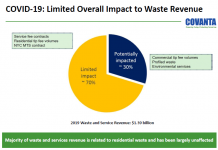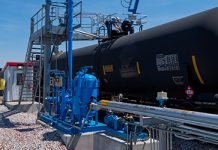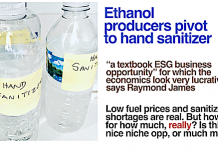Jim Lane
As the renewables industry searches for effective business models, a strong one emerges in its midst. We look at Green Plains (GPRE) and its businesses.
A recurring theme among the 300+ delegates at ABLC Next this week in San Francisco is the recognition that successful companies change the world not science projects, or failed companies and that any route that leads across the Valley of Death to commercial success is the first step towards a sustainable economy, and that strong lead products are the oxen that get settlers across the desert.
Renewable fuels are sold as a commodity and are produced from other commodities and market prices in commodities swing hard, and success today does not guarantee success tomorrow. But it’s a good moment to pause and reflect on what others can learn from the Green Plains way.
Lessons learned
1. Get a lead product that’s a platform for a company. Green Plains began as a one-horse ethanol producer with two products, corn ethanol and distillers grains. There were unanswered questions at the time about the market acceptance of the products, the viability of the sector, and whether Green Plains could scale to industry-leading size, and when.
2. They chose, in corn ethanol, a product that can support a company, rather than ease a burn rate and provide some hope to investors. There are $1 million lead products and $100 million lead products and $1 billion lead products. The first provides hope and not much more, the second eases a burn rate, the latter can support a company.
3. Gain strength by appplying advanced tehcnologies to advance the business proposition
Today, Green Plains has more than a billion gallons in ethanol production capacity, and is making money even in a tough ethanol market; it has spun off Green Plains Partners (GPP) into a successful IPO and reported its first dividend to shareholders in that venture this week; it has diversified into corn oil and is working hard on monetizing its CO2 production. It is acquiring terminal capacity as well as production capacity.
The latest from Green Plains: The Q3 results
Green Plains recorded net Q3 income of $6.2 million, or $0.16 per diluted share, compared to net income of $41.7 million, or $1.03 per diluted share, for the same period in 2014. Revenues were $742.8 million for the third quarter of 2015 compared to $833.9 million for the same period in 2014.
“We are pleased with our results considering the tight margin environment experienced during the third quarter,” said Todd Becker, president and chief executive officer. “Based on the recent improvement in the forward curve for ethanol margins and current market fundamentals, we believe our fourth quarter operating income will exceed the third quarter of 2015.”
During the third quarter, Green Plains’ ethanol production totaled 215.6 million gallons, or approximately 83.8% of its daily average production capacity. The consolidated ethanol crush margin was $34.9 million, or $0.16 per gallon for the third quarter of 2015, compared to $82.8 million, or $0.34 per gallon for the same period in 2014.
“With our recent acquisition activity, we are putting our strong balance sheet to work for our shareholders,” Becker said. “The purchase of ethanol plants in Hopewell and Hereford, along with expansion projects completed to date, will increase our production capacity to over 1.2 billion gallons per year. We believe each of these transactions will be accretive to earnings in the near term.”
“Global demand for ethanol remains strong, with domestic blending occurring at a record pace and ethanol exports running approximately 6% ahead of last year,” continued Becker. “For the third quarter, ethanol export sales were 21% of our production.”
Expansion activity
- As part of its Phase I ethanol production capacity expansion program, the company has added 35 million gallons of production capacity at a cost of $19.6 million through Oct. 1, 2015. The company anticipates adding another 30 million gallons of production capacity during the first quarter of 2016 and 20 million gallons of production capacity in the second quarter of 2016. The total cost of the Phase I expansion is estimated to be approximately $50 million, or $0.59 per gallon.
- On Oct. 26, 2015, Green Plains announced that it had acquired an ethanol production facility in Hopewell, VA. Operating at full capacity, the facility’s dry mill ethanol plant will increase the company’s annual production capacity by approximately 60 million gallons. Production is expected to resume by the end of 2015 with corn oil processing expected to be operational during the second quarter of 2016.
- On Nov. 2, 2015, Green Plains announced that it had signed a definitive agreement regarding the purchase of an ethanol production facility located in Hereford, TX with approximately 100 million gallons of annual production capacity. Under the terms of the agreement, Green Plains will acquire Hereford Renewable Energy, LLC for approximately $93.8 million.
Analyst reaction
Raymond James analyst Pavel Molchanov writes:
“Green Plains Partners is a derivative play on the U.S. corn ethanol industry, one of the most mature elements of the renewables spectrum. But in contrast to the typical “ethanol stock,” this is a fee-based MLP with zero commodity risk. The name of the game will be dropdowns from the parent company, a long-standing consolidator in a fragmented industry – and there is ample news on that front. Bearing in mind the lofty yield attributes, we reiterate our Strong Buy rating, as detailed in our initiation report from July 21.
* 3Q15 recap. This was the MLP’s first full quarter as a stand-alone public company, so historical comparisons are not meaningful. Revenue of $21.4 million (90% from the parent company) came in below our estimate of $23.6 million, but gross margin of 64% topped our model. Distributable cash flow of $12.9 million was marginally below our model, and coverage was just under 1.0x. The first quarterly distribution, $0.40/unit, has already been declared and will be paid on November 13. We anticipate that the first increase (up a penny to $0.41) will come next quarter.
* Dropdowns… one very soon, one a bit later. Ahead of the 3Q results, yesterday the parent company announced its second ethanol plant acquisition within a week – quite the M&A mini-boom in the ethanol space. The 100 million gallon plant in Texas is being bought from the fuel distributor Murphy USA for $94 million, below replacement value. As with the Virginia acquisition from last Monday, the Texas plant’s associated midstream assets will be dropped down to the MLP. These include a shuttle unload facility and a 4.8 million gallon storage facility. Both acquisitions bolster export capabilities, as the facilities are located near coasts. The Texas plant also has the advantage of being in an area with the world’s largest concentration of cattle in the world, ensuring robust demand for distillers’ grains. The timing of the Virginia dropdown is not as clear (we are modeling mid-2016), but the Texas dropdown should come over the next few months.
* Broader thoughts on ethanol. On September 2, we wrote about the fact that ethanol pricing is temporarily above gasoline – a very unusual state of affairs by historical standards. We pointed out that, despite this headwind, the impact on U.S. ethanol demand is likely to be minimal. The weekly EIA petroleum reports largely confirm this. Despite the non-stop volatility in commodity prices, U.S. ethanol production has remained remarkably stable. As it stands, ethanol production has ranged between 900 and 1,000 Mbpd for 24 straight weeks – and 49 out of the past 51 weeks. What this shows is that industry volumes are essentially immune to what’s happening with pricing.
Jim Lane is editor and publisher of Biofuels Digest where this article was originally published. Biofuels Digest is the most widely read Biofuels daily read by 14,000+ organizations. Subscribe here.








